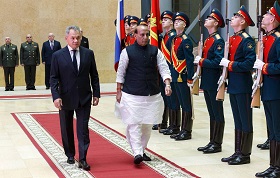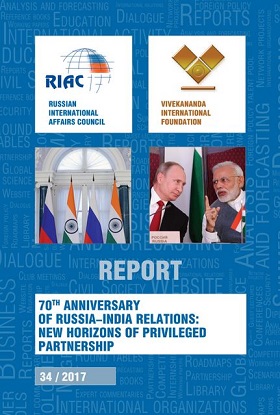Prepared in the framework of the RIAC and Indian Council of World Affairs (ICWA) Joint Paper
India and Russia over the past 71 years have worked on their relationship to take it to the level of a ‘special and privileged’ strategic partnership. The annual summits that has been taking place since 2000 have helped in making an overall assessment on the wide-ranging aspects of political and strategic cooperation, military and security cooperation, cooperation in the spheres of economy, energy, industry, science and technology, etc.[1] The 19th summit was held in New Delhi on October 2018 where the two leaders, Indian Prime Minister (PM) Narendra Modi and Russian President Vladimir Putin took stock of the bilateral relationship and also discussed on the future avenues to strengthen the partnership.
The aim of this paper is to review the progress made in two specific areas i.e. the economic and energy sectors of bilateral cooperation based on the 19th Annual Summit Joint Statement “India-Russia: an Enduring Partnership in a Changing World”.
Present levels of Economic Cooperation between the Old and Established Strategic Partners is there than optimum
In the economic sphere, which is one of the important pillars of the bilateral relationship, India and Russia are far from utilizing their potential in cooperation. Both sides are trying to address these lacunae and expand this sector. However, developments to date have been uneven.
In 2010, for example, after the annual trade volume reached US $8.5 billion, India and Russia hoped and agreed that the trade volume by 2015 would touch US $20 billion [2]. But in 2015–2016 the total trade turnover stood at US $6.17 billion, and in 2016–2017 at US $7.48 billion. An upward trajectory was however maintained in 2017–2018 with the annual trade touching US $11 billion, a 20 per cent increase [3]. However, in the next year, 2018–2019, the turnover shrunk and stood at US$8.2 billion 4. The inconsistency in trade flows puts the target of achieving the target of US $30 billion by 2025 [5] challenging. The two countries need to disaggregate reasons behind the inconsistency in overall growth in the trade volumes. They also need to isolate reasons of Russia not featuring in the top 25 export destinations or importer sources for India [6] despite being a ‘special and privileged’ strategic partner.
According to the Indian Department of Commerce, exports from India to Russia in 2019 (April–September) were at US$ 1.38 billion with an increase of 21.87 per cent [7] over the previous year 2018 (April–September). In 2018 (April–September), export from India stood at US $1.13 billion. India’s import from Russia was at US$ 3.4 billion in 2019 (April–September) in comparison to US $2.7 billion in 2018 (April–September). This shows a growth of 26.45 per cent [8]. The graph of India’s export shows an upward direction from 2015:
India’s Export to Russia
|
(April–September) 2015
|
(April–September) 2016
|
(April–September) 2017
|
(April–September) 2018
|
(April–September) 2019
|
|
US$75 million
|
US$93.6 million
|
US$1.03 billion
|
US$1.13 billion
|
US$1.38 billion
|
Source: System on Foreign Trade Performance Analysis (FTPA) Version 3.0, Department of Commerce [9]
India’s Import from Russia
|
(April–September) 2015
|
(April–September) 2016
|
(April–September) 2017
|
(April–September) 2018
|
(April–September) 2019
|
|
US$2.4 billion
|
US$2.3 billion
|
US$4.2 billion
|
US$2.7billion
|
US$3.4 billion
|
Source: System on Foreign Trade Performance Analysis (FTPA) Version 3.0, Department of Commerce [10]
Investment
An area of growth could be investments. Indian investments in Russia are estimated to be about US $13 billion which include Vankorneft and Taas-Yuryakh fields; Imperial Energy Tomsk; Sakhalin I; Volzhsky Abrasive Works Volgograd; and Commercial Indo bank. Russian investments in India total about US$16 billion, including the acquisition of the ESSAR Oil Ltd [11], Kamaz Vectra in Hosur; Shyam Sistema Telecom Ltd, Sberbank and VTB [12]. Both sides had expressed their desire to raise the level of investments in each other’s countries to US $ 15 billion (each way) by 2025 [13]. Russian investments in India are mostly focused on the energy and defence sectors with smaller investments in banking and e-commerce set-ups such as Flipkart and Ola. The September 2019 announcement of the Indian $1 billion line of credit in the Far East provides a new avenue for investment [14].
New areas of economic cooperation between India and Russia could be innovation and technology [15], digitalisation and infrastructure [16], and the alternative and renewable energy sectors. Apart from bilateral investments, India and Russia can jointly invest in agribusiness and renewable energy in Afghanistan.
Energy and Nuclear Cooperation holds the most potential
In the energy sector, India and Russia’s mutual investments scenario looks bright. As noted, the Petroleum and Natural Gas sector witnessed the single largest FDI during 2016–2017, by a consortium led by Russian companies in Esssar’s Vadinar Refinery with an investment of around US $13 billion. At the same time, Indian Central Public Sector Enterprises (CPSEs) acquired 29.9 per cent stake in Taas-Yuryakh oil field and 49.9 per cent stake in Vankorneft [17]. These acquisitions have added equity in oil and gas sectors for Indian PSUs in their overseas portfolios [18].
According to the Indian Petroleum & Natural Gas Statistics Report 2017-2018, Russia has 106.2 thousand million barrels of the world’s proven oil reserves. In comparison, the US has 50 while Venezuela has 303.2 and Canada has 168.9 thousand million barrels in 2017 [19]. Energy demand of India is anticipated to grow faster than energy demand of all major economies because of continuous robust economic growth. Consequently, India’s energy demand as a percentage of global energy demand is expected to rise to 11 per cent in 2040 from 5.58 per cent in 2017. This complimentary by far provides the most potential for growth of economic cooperation between India and Russia.
In nuclear energy, India’s cooperation with Russia contributes to India’s energy security [20]. The Kudankulam Nuclear Power Plant (KKNPP) Units 1 and 2 are operational while Units 3 and 4’ are under construction. The agreement for Units 5 and 6 is been concluded [21]. There are plans for 12 more nuclear power stations to be built in India [22]. With the agreement on localisation of manufacturing of nuclear equipment in India, this will be another area of cooperation between the two countries [23]. Joint projects in third countries such as the Rooppur NPP in Bangladesh further help in strengthening cooperation in this field.
Conclusion
The India-Russia relationship has endured over time despite the changing geopolitical situations. Both desire to continue to expand a robust strategic partnership. Enlarging economic stakes in each other’s progress is therefore vital for strengthening the political and security relationship. An enlarged area of economic cooperation will also insulate political relations from the inevitable geopolitical fluctuations given the regional and global flux that exists.
1. “India-Russia: an Enduring Partnership in a Changing World”, Joint Statement: Ministry of External Affairs, October 5, 2018. https://mea.gov.in/bilateral-documents.htm?dtl/30469/IndiaRussia_Joint_Statement_during_visit_of_President_of_Russia_to_India_October_05_2018, Accessed on August 4, 2019.
2. “India and Russia to Boost Trade up to $20 billion “, India Briefing, June 20, 2011. https://www.india-briefing.com/news/russia-india-boost-trade-us20-billion-4873.html / Accessed on September 7, 2019.
3. “Press statements following Russian-Indian talks”, President of Russia, September 4, 2019. http://en.kremlin.ru/events/president/news/61442 Accessed on September 14, 2019.
4. “India, Russia agree to step up trade to $30 bn by 2025”, Business Line, September 4, 2019. https://www.thehindubusinessline.com/economy/india-russia-agree-to-step-up-trade-to-30-bn-by-2025/article29332019.ece Accessed on November 15, 2019.
5. “India-Russia Joint Statement during visit of Prime Minister to Vladivostok: Reaching New Heights of Cooperation through Trust and Partnership”, Ministry of External Affairs, September 5, 2019. https://www.mea.gov.in/bilateral-documents.htm?dtl/31795/India__Russia_Joint_Statement_during_visit_of_Prime_Minister_to_Vladivostok Accessed on November 15, 2019.
6. Indian Trade Portal website. https://www.indiantradeportal.in/vs.jsp?lang=0&id=0,25,45,858,859 Accessed on September 15, 2019. However, in the field of pharmaceuticals, Russia features as one of the top 10 export destination country. In 2018-2019, it touched US$ 485.55 million in 2018-2019 whereas in 2017-2018, it was US$468.77 million and in 2016-2017, it stood at USD$383.46 million. “Export Products (Pharmaceuticals)”, Ministry of Commerce and Industry, 2019. https://commerce.gov.in/InnerContent.aspx?Id=506.
7. “Export by Region x Countries”, System on Foreign Trade Performance Analysis (FTPA) Version 3.0, Department of Commerce, November 13, 2019. https://commerce-app.gov.in/ftpa/rgncnt.asp Accessed on November 13, 2019.
8. “Import by Region x Countries”, System on Foreign Trade Performance Analysis (FTPA) Version 3.0, Department of Commerce, November 13, 2019. https://commerce-app.gov.in/ftpa/rgncnt.asp Accessed on November 13, 2019.
9. Department of Commerce, https://commerce-app.gov.in/ftpa/default.asp Accessed on November 13, 2019.
10. Department of Commerce, https://commerce-app.gov.in/ftpa/default.asp Accessed on November 13, 2019.
11. The deal included acquisition of Essar Oil Ltd., India’s largest network of private petrol pumps, the country’s second-largest refinery, a 1,000-MW power plant along with the Vadinar port and oil terminal. “Essar Oil completes $13 billion sale to Rosneft-led consortium in largest FDI deal”, Economic Times, August 22, 2017. https://economictimes.indiatimes.com/markets/stocks/news/essar-oil-completes-sale-of-india-assets-to-rosneft-for-12-9-bn/articleshow/60154679.cms Accessed on November 15, 2019.
12. Sberbank and VTB helps in financing energy and defence projects.
13. “India-Russia Relations”, Ministry of External Affairs, August 2017. https://mea.gov.in/Portal/ForeignRelation/Russia_August_2017.pdf, Accessed on September 28, 2019.
14. Apart from energy, India is investing in health, education, skill development, mining and timber. Elisabeth Roche, “India announces $1 billion line of credit to resource-rich Russian Far East”, The Mint, September 6, 2019. https://www.livemint.com/news/india/india-extends-1-billion-line-of-credit-for-development-of-russia-s-far-east-1567674855140.html Accessed on September 29, 2019. There are also talks between the two sides to invest in the space of fisheries and cold chain logistics. “Russian investors keen on Ladakh solar power project: Invest India”, Economic Times, September 6, 2019. https://economictimes.indiatimes.com/industry/energy/power/russian-investors-keen-on-ladakh-solar-power-project-invest-india/articleshow/71006305.cms?from=mdr Accessed on September 29, 2019.
15. “Russia in M&A Report 2018”, KPMG, 2018, pg. 8, http://assets.kpmg/content/dam/kpmg/ru/pdf/2019/02/ru-en-ma-survey-feb-2018.pdf Accessed on September 25, 2019. India and Russia have been collaborating in the Indian Railway sector too. For further details please refer “Indo-Russia Train Gain”, Made in India, 2017. http://www.makeinindia.com/article/-/v/70-years-of-india-russia-partnership-in-the-railways, Accessed on September 28, 2019.
16. Russia whose economy is mainly dependent on hydrocarbons and commodities is trying to diversify itself to digitalisation and infrastructure improvement. The Russian investors, such as DST, have shown greater interest in the foreign Innovation & Technology companies. “Russia in M&A Report 2018”, KPMG, 2018, pg.8, op.cit.
17. “ONGC Videsh Limited – Working globally for the Energy Security of India”, ONGC, https://www.ongcindia.com/wps/wcm/connect/en/about-ongc/subsidiaries/ongc-videsh-limited/ Accessed on October 9, 2019.
18. “Annual Report 2016-2017”, Ministry of Petroleum & Natural Gas, 2017, pg.17. http://petroleum.nic.in/sites/default/files/AR16-17.pdf, Accessed on October 9, 2019.
19. “Indian Petroleum & Natural Gas Statistics 2017-2018”, Ministry of Petroleum and Natural Gas: Economic and Statistics Division, September 2018, pp.143-144. http://petroleum.nic.in/sites/default/files/ipngstat_0.pdf Accessed on October 10, 2019.
20. “India-Russia: an Enduring Partnership in a Changing World”, Joint Statement: Ministry of External Affairs, October 5, 2018, op.cit.
21. “India-Russia Relations”, Ministry of External Affairs, August 2017. https://mea.gov.in/Portal/ForeignRelation/Russia_August_2017.pdf, Accessed on October 15, 2019.
22. Chetan Kumar, “India to have 12 more nuclear power plants soon: DAE Chief”, Times of India, April 22, 2019. https://timesofindia.indiatimes.com/india/india-to-have-12-more-nuclear-power-plants-soon-dae-chief/articleshow/68994453.cms?from=mdr, Accessed on October 19, 2019.
23. “Heavy Engineering: Close Ties”, Made in India, 2017. http://www.makeinindia.com/article/-/v/70-years-of-india-russia-heavy-machinery-highlights, Accessed on October 19, 2019.







